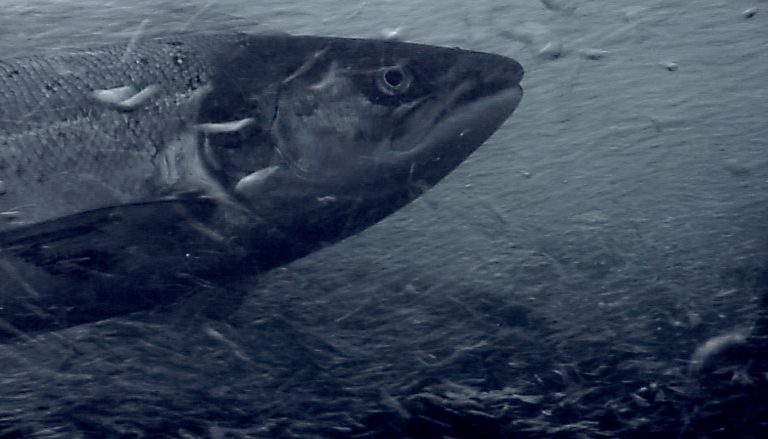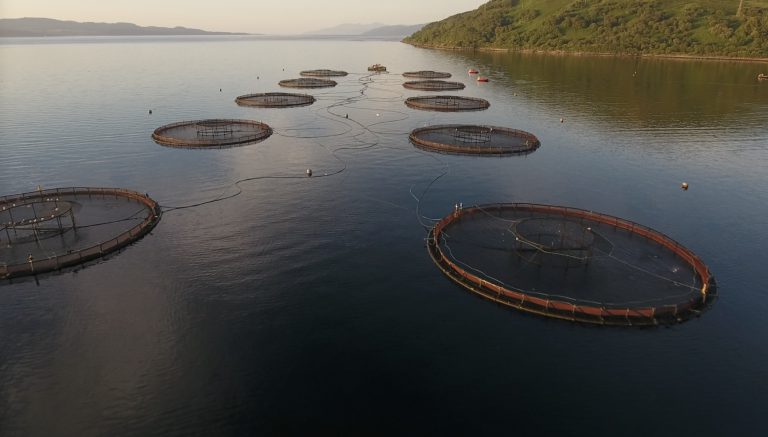
Atlantic salmon occur in the rivers of countries that border both sides of the North Atlantic, and in the Baltic.
The UK’s salmon population are a significant proportion of the total European stock and Scottish rivers in particular are a European stronghold.
Salmon are an iconic Scottish animal, running rapids and leaping waterfalls to reach their spawning grounds, which including a number of rivers in the Hope Spot area.
Spawning usually occurs from November to December, but may be later in larger rivers. These young fish (parr) live in the river for two to three years, then transform into smolts that can survive at sea, usually leaving their rivers in the spring.
Little is known about the migration routes of returning adults or out-going post-smolts. Some research suggests that they move in schools when heading to feeding areas. Some go to the Norwegian Sea and the waters off southwest Greenland.

Image: SNH
Salmon provide food for seals and dolphins, and salmon angling provides jobs in many communities on the west coast of Scotland.
Surviving adult salmon migrate back to Scotland, returning to precisely the same stretch of the river where they were born, most likely locating their natal rivers by the unique chemical signature of their water. This means that many ‘populations’ of Atlantic salmon may exist within the same river. Many adults die after spawning but some return to the sea and will return to breed again.
Salmon and sea trout are vital to the survival of Scotland’s rare freshwater pearl mussel. These mussels can live for more than 100 years but they cannot reproduce unless their larvae spend time inside the gills of wild salmonid fish.
The multi-sea-winter component of the Atlantic salmon population is a UK Biodiversity Action Plan priority fish species. They are also listed on Schedule 3 of the Conservation (Natural Habitats, &c.) Regulations 1994 and are a Scottish Government Priority Marine Feature species, meaning that developments are not allowed to affect the national or international status of their population.
Scotland has some EU Special Areas for Conservation for Atlantic salmon but there are none in the Hope Spot area. The Atlantic salmon is an EU Annex II species only in freshwater, so marine and estuarine sites cannot become SACs.
2019 is the International Year of the Salmon, an initiative of the North Atlantic Salmon Conservation Organization (NASCO), established by an inter-governmental Convention in 1984. NASCO aims to conserve, restore, enhance and rationally manage Atlantic salmon through international co-operation, taking account of the best available scientific information. Britain is a signatory because of its membership of the EU.
History
Historically, salmon were very numerous in Scotland and were widely caught for food as well as sport.
The largest one caught on a rod and line in the UK was in the River Tay in 1922: it weighed 64lbs (29kg). There is an 1891 report of a salmon of 70lbs, also caught in the River Tay.
The largest recorded Atlantic salmon ever recorded came from Norway’s Tana River. It weighed 35.89 kg and was over 150 cm long.
Research
The Scottish Government is conducting research into the migration routes of wild salmon, and comparing return rates of smolts to east coast and west coast rivers. This knowledge is vital, given that the number of salmon caught by anglers or recorded by fish counters in some west coast rivers has fallen to their lowest level ever recorded; for instance in the Hope Spot’s River Awe.
In general, rivers in the west coast’s ‘aquaculture zone’ have seen steeper falls than salmon rivers elsewhere, adding to the suspicion that fish farms (which are not permitted on Scotland’s other coasts) are adding to the wild salmons’ problems. This conclusion is supported by research from Ireland and Norway.

Threats
Salmon stocks have been falling all around the North Atlantic for a number of years. Early-running or ‘spring’ fish, have suffered particularly badly.
Actual stock levels are difficult to estimate, except on rivers with reliable counting facilities, but catch figures can give an indication, particularly of trends.
This decline has a number of causes, including changes in water quality and barriers across rivers, such as dams. Climate change is also warming the sea and affecting where salmon can find food. They are still killed by commercial fishermen, especially off the west coast of Greenland, and sometimes when they return to their home waters. They are also at risk from sea lice, naturally occurring parasites which multiply in fish farms and can transfer to wild fish. Farmed fish also escape, and as they are mostly of Norwegian stock, selected to grow quickly, they can outcompete or interbreed with wild fish, reducing their ability to survive in their home rivers and to migrate. Diseases such as Infectious Salmon Anaemia can be passed from farmed fish to their wild relatives.
Uneaten food, dissolved nutrients, fish waste and the pesticides used to treat farmed salmon, pass through the nets of their cages and pollute the open water, potentially enhancing harmful algal blooms that can kill fish. On the seabed this pollution can kill marine life.
Atlantic Salmon
Salmo salar

Image: Lorne Gill, SNH
Protected species, UK Biodiversity Action Plan Priority fish species
Length: 75-160cm
Weight: 4-49kg

